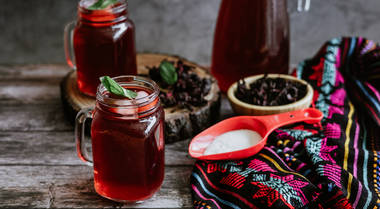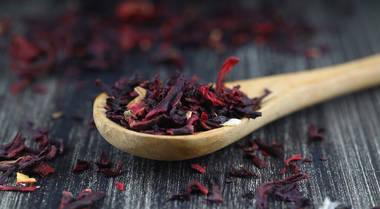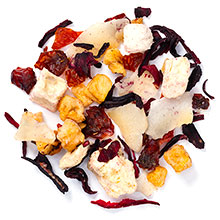Sour Power: Introducing the Hibiscus Flower
June 23, 2025

Red, Radiant, and Ready to Sip
Ever poured yourself a glass of deep ruby-red iced tea and wondered where that bold color and tart, tangy flavor comes from? Chances are, you were sipping hibiscus. With its vibrant hue and refreshing zing, hibiscus is a star in many summer tea blends. But this beautiful flower isn’t just easy on the eyes. It's steeped in history, packed with wellness benefits, and tastes as bright as it looks.If you’re new to herbal teas or just curious about what makes this floral ingredient so beloved across the globe, you’re in the right place. Let’s explore what hibiscus tea is all about, and why it’s one of the most popular herbal ingredients in the world.
Find our vibrant petals on our spice site, Selefina.
What Exactly Is Hibiscus?
At its core, hibiscus tea is made by steeping the dried petals of the Hibiscus sabdariffa flower. What you get is a tart, cranberry-like infusion that’s as gorgeous as it is delicious. While technically not a "tea" (since it contains no actual tea leaves), hibiscus is one of the most widely consumed herbal infusions in the world.You might not realize it, but hibiscus goes by many names depending on where you are: sorrel in the Caribbean, karkadeh in Egypt and the Middle East, flor de Jamaica in Mexico, and bissap in parts of West Africa. Each region has its own way of preparing and enjoying it, but the ingredient remains the same: dried hibiscus calyces, which are the deep red parts of the flower just beneath the petals.
Tart, Bright, and Bold
Hibiscus tea is anything but subtle. Its flavor is tangy, fruity, and slightly floral. Many people compare it to cranberry or pomegranate. If you like your teas with a bit of a zing, hibiscus is your new best friend.That boldness makes it incredibly versatile. It pairs beautifully with other fruity or citrusy ingredients like orange peel, berries, and lemon, and also balances out nicely with sweeter herbs or spices. One of our summer blends, Key Lie Herbal, features hibiscus as a key ingredient alongside rose hips, orange peels, and apple for a citrusy, thirst-quenching brew.
Want to mellow it out? Add a drizzle of honey or agave. For a fun twist, try it with a slice of orange, or a few fresh mint leaves for a truly refreshing iced tea.

A Global Favorite: Hibiscus Around the World
Hibiscus tea isn’t just a trendy health beverage—it’s been a staple in hot climates for centuries. Its naturally cooling properties and vibrant flavor have earned it a permanent spot in cultures around the world.In Mexico and Central America, you’ll find agua de Jamaica offered at almost any eating establishment or made fresh at home. In West Africa, it’s called bissap and is commonly served at celebrations. Egyptians drink karkadeh, a cold hibiscus tea that’s both refreshing and culturally symbolic. In the Caribbean, hibiscus (or "sorrel") is brewed with spices like ginger and cloves for a richer, deeper version, especially popular during the holidays.
These drinks may differ in preparation, but they all celebrate hibiscus for the same reasons: it’s beautiful, full of flavor, and helps keep cool.
Health Benefits of Hibiscus Tea
Beyond the color and taste, hibiscus tea brings some real wellness perks to the table. It’s naturally caffeine-free, which means you can drink it morning, noon, or night without worrying about jitters or sleep disruption. That alone makes it a go-to for anyone looking to cut back on caffeine. Especially during the hot summer months!Hibiscus is also packed with antioxidants, particularly anthocyanins, which are the compounds responsible for its rich red hue. These antioxidants are known to support heart health, and some studies have shown that hibiscus tea may help lower blood pressure. It’s also a source of vitamin C, and is sometimes used traditionally to aid digestion and support the immune system.

How to Brew (and Chill) Hibiscus Tea
Hibiscus tea is easy to make and incredibly flexible. Whatever your tea brewing level, you’ll find it easy to enjoy.
To make a classic hot brew:
- Use 1–2 teaspoons of loose-leaf hibiscus tea (or a blend like our Piña Colada tea blend) per 8 oz of water.- Steep in hot water (just under boiling) for 5–10 minutes.
- Strain and enjoy as-is, or add honey for a bit of sweetness.
For an iced version:
- Double the amount of tea to make a more concentrated brew.- Let it steep, cool to room temperature, then pour over ice.
*Optional: add citrus slices, a splash of lemonade, or a few fresh berries.
Or, if you’re feeling adventurous, try cold brewing: place your tea in cold water, pop it in the fridge overnight, and wake up to a smooth, chilled infusion with a bit less tartness. You can even freeze brewed hibiscus into ice cubes or popsicles for an extra-fun summer treat.
Add a Little Hibiscus to Your Summer
Hibiscus tea checks all the summer boxes: it’s colorful, caffeine-free, loaded with flavor, and incredibly refreshing. Whether you’re making a pitcher for the patio, sipping it after a little exercise, or just looking for something bright and cool to replace your usual iced coffee, hibiscus fits right in.However you enjoy it, hibiscus makes it easy to stay hydrated, inspired, and comfortable in the summer heat. It’s a drink with a history and reputation around the world that speaks for itself. So start brewing and enjoy!